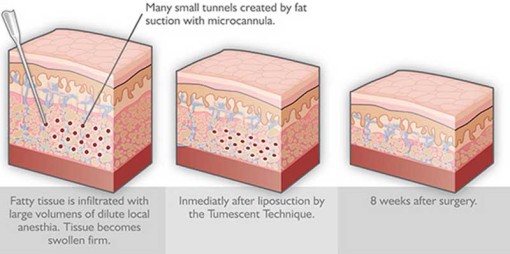Liposuction – More than Just a “Thigh Helper”
Mention liposuction and most people automatically think of saddlebag thighs sucked clean of every morsel of excess fat. And liposuction can and is used to slim down thighs. But resourceful doctors have also found liposuction to be a handy way to defat wiggly areas elsewhere — annoying features like a double chin, jowls or other pouches of fat that you know you didn’t have back when you were studying logarithms in the l2th grade.
Besides trimming a double chin, puffy neck or jowls, liposuction — in which a surgeon uses a thin, hollow metal tube called a cannula to aspirate, or suck away, body fat through small incisions in the skin — can also streamline problem areas like the hips, stomach and buttocks and improve the appearance of cellulite, that rippled, orange-peel-textured fat. And unlike dieting, which merely reduces the size of fat cells, liposuction gets rid of these cells permanently.
Like any other type of cosmetic surgery, liposuction entails some risk. But experts say a technique developed within the past few years has significantly reduced this procedure’s potential for complications. So if you want a trimmer jawline, chin or neck or a sleeker figure, liposuction might be right for you.
Great Aspirations
Liposuction originated in Italy in the mid-1970s and immigrated to the United States in the early 1980s. But back then, liposuction was risky: People chanced trading excess fat for permanently dimpled skin that looked (ironically) like cellulite. Further, traditional liposuction depended on general anesthesia — the kind that acts on the brain and central nervous system, rendering you completely unconscious. (General anesthesia tends to cause more complications than local anesthesia, which numbs only the area to be treated.) Worst of all, liposuction often caused severe blood loss, and people who underwent this procedure often needed blood transfusions.
Within the past few years, however, most surgeons have stopped administering traditional liposuction and use a newer procedure called tumescent liposuction. In this procedure, a surgeon injects the area with a special solution to make fatty tissue “tumescent,” or swell up. This solution contains a local anesthetic to numb the area being treated, a chemical that temporarily shrinks capillaries to minimize blood loss and a drug that lessens bruising and swelling.
Performed correctly, tumescent liposuction is virtually painless. What’s more, you’ll be able to leave the doctor’s office a half-hour after the procedure. You’ll feel sore 10 to 16 hours after the procedure as the anesthesia wears off. But you can usually ease this discomfort with an over-the-counter pain reliever. You’ll also have to wear two elastic support garments for two to five days until your skin contracts along your new, trimmer contours.
The most important benefit of tumescent liposuction is safety. This procedure significantly reduces blood loss to a few tablespoons and completely eliminates the complications that can arise from general anesthesia. Many experts agree that tumescent liposuction is safer and more predictable than traditional liposuction. Like any medical procedure, tumescent liposuction does have certain risks.
Good-bye Saddlebags and Love Handles
Liposuction can do more than pare down a puffy profile. This procedure can also eliminate stubborn fat on the hips, thighs, stomach, upper arms, calves, knees and ankles. Liposuction can also slim hips and thighs by one or two sizes. This is good news if your bottom half has always been a size or two larger than your top half, making it hard to find a suit or dress that fits.
What’s more, it’s possible to see the benefits of this procedure immediately. You can look thinner the next day. You’ll see 95 percent of what you’ll ultimately look like in four to six weeks, as swelling fades and incisions heal.
Liposuction isn’t the lazy woman’s way to a svelte figure, though: There’s still no substitute for a prudent diet and regular exercise. Liposuction is not a treatment for general obesity and while smaller cannulas can help minimize the look of cellulite, tumescent liposuction can’t work miracles. Liposuction won’t eliminate cellulite, but it can improve its appearance.
Know the Risks
Experts say that tumescent liposuction has significantly reduced the two biggest risks of traditional liposuction — blood loss and complications arising from the use of general anesthesia. But they add that tumescent liposuction, like any type of surgery, carries inherent risks, including dimpled skin, permanent numbness in the treated area, scarring and an allergic reaction to the local anesthesia. So talk to a surgeon about this procedure’s potential for complications during your initial consultation. As for traditional liposuction, most surgeons no longer perform this procedure. But in addition to the risks mentioned above, you should know that it can also result in permanent darkening of the skin (hyper pigmentation), nerve damage, infection and shock (depending on the amount of fat removed).

